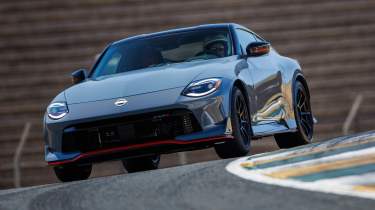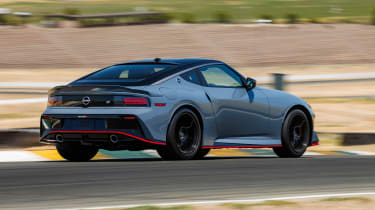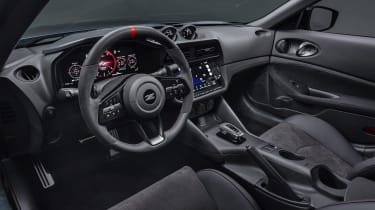2024 Nissan Z Nismo revealed with 420bhp
Nissan has given us a first look at the range-topping Z Nismo coupe, but it still won’t make it to UK shores
Almost two years since the launch of the production-ready Z sports coupe, Nissan has uncovered the range-topping Nismo. Following in the footsteps of the hardcore GT-R and 370Z Nismo, the model receives a power bump, uprated cooling, chassis enhancements and a more aggressive Nismo body. Order books open later this year, but as with the standard car, we won’t receive it in the UK.
The Nissan Z shares its two-seater two-door configuration (and underlying chassis) with its 370Z predecessor. At 4382mm long the Z is 142mm longer than the 370, and almost bang-on the same length as a Toyota GR Supra. At 1850mm wide and 1310mm tall it is a little narrower and taller than the Toyota, but has an identical footprint on the road with a combination of 255/40 R19 front and 275/35 R19 rear rubber (on the upper two trim levels).
> Nissan GT-R Nismo (2020-2022) review
Under the bonnet is a twin-turbocharged V6, specifically the VR30DDTT unit that powers high-specification variants of the Infiniti Q50 and Japanese-market Nissan Skyline. In range-topping Nismo-form, power stands at 420bhp and 384lb ft of torque, up 20bhp and 34lb ft over the standard car. To achieve this, Nissan increased boost pressure and turbine speed, employed a GT-R-inspired ignition spark timing strategy and uprated the oil cooler for extended track sessions. Also new to the Nismo are stiffer spring rates, new, retuned dampers and larger 381mm and 350mm rear brake discs front and rear.
The Z Nismo is available with a 9spd automatic transmission only, while the standard car gets a six-speed manual. All ‘Performance grade’ models feature a totally mechanical limited-slip differential, with a carbonfibre driveshaft, rev-matching function and launch control that’ll electronically hold the revs at the optimum level when the clutch is dipped, ensuring the fastest possible getaway when the clutch is released.
Nissan Z design
Aesthetically, the Nissan Z draws its inspiration from two of its most famous predecessors, the original 240Z and the 1990s 300ZX. The silhouette is pure ’70s Nissan, with a long bonnet, wraparound screen, flat roof and familiar C-pillar motif. The nose is dominated by a single aggressive opening, flanked by two LED headlights that, together with their surrounding bodywork, mimic the circular headlights of the 240Z. The Nismo variant receives forged Rays wheels, trademark Nismo red detailing, a wider track and updated aero elements, just like its GT-R relative.
The clean, simple surfacing is another nod to the Zs of yesteryear, ending in a tail that includes some references from the 300ZX around the new LED tail lights. The design is squat, compact and traditional in most senses, and lacks the almost caricature-like expression of a Toyota Supra or Alpine A110.
Nissan Z interior
The Nissan’s interior uses a simple layout dominated not by digital interfaces – although there are many – but by a simple driver-centric graphic that tilts the whole dash towards the driver. As with almost all Zs, three round auxiliary dials are incorporated into the upper dash, while the manual gearlever and handbrake (yes, it has a manual handbrake) sit within a pleasingly restrained centre tunnel.
There is a pretty big catch with the Nissan Z car, however. It won’t be coming to Europe in any of its forms. Nissan Europe confirmed such from the outset, stating: ‘The Nissan Z Proto is an homage to Nissan’s sports car heritage, passion and innovation, updated for the modern age. However, a shrinking European sports cars market and specific regulations on emissions mean that Nissan was unable to build a viable business case for the introduction of the production version of the next generation Z-car in Europe. In Europe, Nissan’s priorities remain on its commitment to renew its crossover line-up and accelerate its range electrification strategy.’
While it is a huge shame that the Nissan Z will not be available locally, it’s important to remember how expensive it is to enter the high performance market in Europe thanks to our tough emissions regulations. Unfortunately it’s the old-school elements that make the Z feel so refreshing in our modern age of dual-clutch transmissions and hybridised powertrains that will also keep it from sales viability here. It is worth remembering, however, that the Nissan-Renault alliance still has a modern, fantastic sports car to take our fancy in the form of the Alpine A110, a car we feel is still a superb example of how good a lightweight, relatively affordable sports car can be when engineered with the right tools and by the right teams.
> Nissan R34 Skyline GT-R multifunction display – Art of Speed








